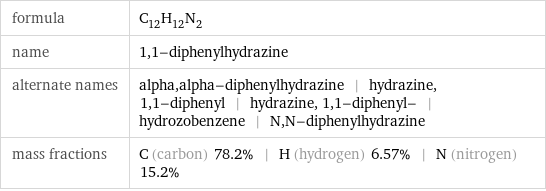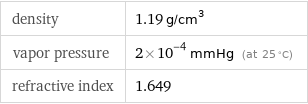Input interpretation

1, 1-diphenylhydrazine
Chemical names and formulas

formula | C_12H_12N_2 name | 1, 1-diphenylhydrazine alternate names | alpha, alpha-diphenylhydrazine | hydrazine, 1, 1-diphenyl | hydrazine, 1, 1-diphenyl- | hydrozobenzene | N, N-diphenylhydrazine mass fractions | C (carbon) 78.2% | H (hydrogen) 6.57% | N (nitrogen) 15.2%
Lewis structure

Draw the Lewis structure of 1, 1-diphenylhydrazine. Start by drawing the overall structure of the molecule, ignoring potential double and triple bonds: Count the total valence electrons of the carbon (n_C, val = 4), hydrogen (n_H, val = 1), and nitrogen (n_N, val = 5) atoms: 12 n_C, val + 12 n_H, val + 2 n_N, val = 70 Calculate the number of electrons needed to completely fill the valence shells for carbon (n_C, full = 8), hydrogen (n_H, full = 2), and nitrogen (n_N, full = 8): 12 n_C, full + 12 n_H, full + 2 n_N, full = 136 Subtracting these two numbers shows that 136 - 70 = 66 bonding electrons are needed. Each bond has two electrons, so in addition to the 27 bonds already present in the diagram add 6 bonds. To minimize formal charge carbon wants 4 bonds. Identify the atoms that want additional bonds and the number of electrons remaining on each atom: Fill in the 6 bonds by pairing electrons between adjacent highlighted atoms. Note that the six atom rings are aromatic, so that the single and double bonds may be rearranged: Answer: | |
3D structure

3D structure
Basic properties

molar mass | 184.24 g/mol phase | solid (at STP) melting point | 34.5 °C boiling point | 330 °C density | 1.19 g/cm^3 solubility in water | insoluble
Units

Solid properties (at STP)

density | 1.19 g/cm^3 vapor pressure | 2×10^-4 mmHg (at 25 °C) refractive index | 1.649
Units

Thermodynamic properties

molar heat of vaporization | 57.3 kJ/mol specific heat of vaporization | 0.311 kJ/g (at STP)
Chemical identifiers

CAS number | 530-50-7 Beilstein number | 957349 PubChem CID number | 10739 SMILES identifier | C1=CC=C(C=C1)N(C2=CC=CC=C2)N InChI identifier | InChI=1/C12H12N2/c13-14(11-7-3-1-4-8-11)12-9-5-2-6-10-12/h1-10H, 13H2 EU number | 208-483-1 RTECS number | MV3450000 NSC number | 5937
Safety properties

flash point | 181 °C
Toxicity properties

RTECS classes | mutagen